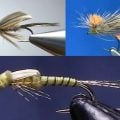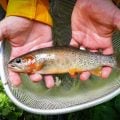How to Tie the Crackleback
Producer: Tim Flagler
The Crackleback was created by Ed Story of Feather-Craft back in 1952. It’s an incredibly versatile pattern that can be fished as either a wet or a dry fly, and can be tied over a wide range of sizes and colors.
For a hook, a Dai-Riki #300 in size 16 works well. Start by mashing the barb and getting the hook firmly secured in the jaws of your tying vise.
For thread, I’ve loaded a bobbin with a spool of rusty brown UTC 70 Denier. Start your thread on the hook shank behind the eye and take a few wraps rearward before snipping or breaking off the tag.
The first material to be tied in is peacock herl which will form the back of the fly. Pull 2 good looking herls free from the rest and lay their tip ends on top of the hook shank. Then, secure them with a pinch wrap. Continue taking thread wraps to bind the herls to the top of the shank, all the way back to the start of the bend. You can then either snip the excess herl tips off clean or fight with them for a while to break them off.
Although furnace is the traditional hackle color used on a Crackleback, I’m fresh out so I’ll use brown. It’s always a good idea to measure the hackle feather prior to plucking. Once you’re satisfied with the barbule length, pull the feather free from the skin. Prep the feather by stripping off the lower fuzzy fibers and leaving about 1/8” of bare stem. Orient the feather so the dull or back side is facing you.
Give your bobbin a counterclockwise spin so the thread will jump rearward during the first wrap. Leaving just a small amount of bare stem showing between the hook and the first fibers, lay the stem against the near side of the hook and take firm thread wraps to hold it there. Continue binding the stem up the shank.
On this Crackleback I’m going to use cream rabbit fur to dub the body. You don’t want it to build up too much so keep the dubbing noodle fairly slim, and about 2” long. Start taking wraps with the noodle so the dubbing begins right at the start of the hook bend and continue wrapping forward, up the shank to create the body of the fly. Do leave a bit of free space behind the hook eye.
Now, pull the peacock herl forward, straight down the middle of the fly’s back and anchor it with a few tight turns of tying thread. You can then reach in with your tying scissors and snip the excess herl tips off close. Get hold of the hackle feather with hackle pliers and start taking open spiral wraps. You should notice that the hackle fibers cant forward as you complete 5 or 6 turns up the body. When you reach the hook eye, use your tying thread to anchor the hackle tip and then, very carefully, snip the excess off close.
Oftentimes, when the hackle’s wrapped like this, you end up with a few fibers covering the hook eye, but they should be fairly easy to snip away at this point. Finally do a 4 or 5 turn whip finish, seat the knot well and snip or cut your tying thread free.
And that’s the Crackleback. I’ve heard of anglers fishing this fly almost exclusively for years on end and consistently doing well.
How to Tie the Copper John
How to Tie the DDH Leech











